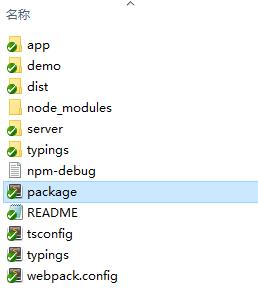形形色色Node工程
Posted tags:
篇首语:本文由小常识网(cha138.com)小编为大家整理,主要介绍了形形色色Node工程相关的知识,希望对你有一定的参考价值。
最近项目要用的

一些无关紧要的文件夹, demo是一些示例, dist是webpack打包后发布的代码,server是用node启动服务,typings和tsconfig是一些ts配置.
npm install 安装node_modules依赖.
npm start 从package.json指定的webpack.config开始运行.
"start": "concurrently \\"webpack --watch --colors\\" \\"nodemon server/main.js\\""

var webpack = require(\'webpack\'); var htmlWebpackPlugin = require(\'html-webpack-plugin\'); module.exports = { entry: { main:[\'./app/main.ts\'], vendor:[ ] }, externals:{ "jquery":"jQuery" }, output: { path: \'./dist\', filename: \'js/app.bundle.js\', publicPath:\'/\' }, module: { loaders: [ {test: /\\.ts$/, loader: \'ts\'}, {test: /\\.html$/, loader: \'raw\'}, {test: /\\.css$/, loader: \'raw\'} ] }, resolve: { extensions: [\'\', \'.js\', \'.ts\', \'.html\', \'.css\'] }, plugins: [ new HtmlWebpackPlugin({ template: \'./app/index.html\' }), new webpack.optimize.CommonsChunkPlugin({ name: "vendor", //filename : \'vendor_[chunkhash].js\', filename : \'js/vendor.js\', minChunks: Infinity }), /*new webpack.optimize.UglifyJsPlugin({ compress: { warnings: false } }),*/ new webpack.DefinePlugin({ app: { environment: JSON.stringify(process.env.APP_ENVIRONMENT || \'development\') } }) ] };
webpack设入口为main.ts
import {platformBrowserDynamic} from \'@angular/platform-browser-dynamic\';
import {AppModule} from \'./app.module\';
platformBrowserDynamic().bootstrapModule(AppModule);
main.ts导入./app.module.ts(import和require的时候后缀名可以省略)使用bootstrapModule方法启动AppModule
在模块app.module.ts中导入angular基础模块以及自定义组件和路由组件.

import \'./polyfills\'; import {BrowserModule} from "@angular/platform-browser"; import {NgModule} from "@angular/core"; import {HttpModule} from \'@angular/http\'; // 表单 双向数据绑定 import {AppComponent} from "./app.component"; import { HomeComponent, TestComponent } from \'./component\'; //路由 import APP_ROUTER_PROVIDERS from "./app.routes"; import {enableProdMode} from \'@angular/core\'; import { LoggerService, GLobalService, UIHelperService } from \'./service\'; enableProdMode(); @NgModule({ imports: [ BrowserModule, HttpModule, APP_ROUTER_PROVIDERS ], declarations: [ AppComponent, HomeComponent, TestComponent ], providers: [ LoggerService, GLobalService, UIHelperService ], bootstrap: [AppComponent] }) export class AppModule { }
自定义组件如果是以页面为划分,比如HomeComponent, TestComponent, 可以在内部再细分功能组件.
例如上面的
import { HomeComponent, TestComponent } from \'./component\';
AppModule中导入页面组件后,在app.routes.ts中作好路由,就可以在html模板中实现页面跳转.
import {RouterModule, Routes } from \'@angular/router\';
import { HomeComponent, TestComponent } from \'./component\';
const routes = [
{path: \'\', component: HomeComponent},
{path: \'test\', component: TestComponent}
];
export default RouterModule.forRoot(routes);
component.ts中
export * from \'./app.component\' export * from \'./components/home/home.component\' export * from \'./components/test/test.component\'
统一export组件, Module中统一import或require, 这是这个工程组织的结构.
AppModule最后也是export一个对象供使用.
上面提到的home组件除了home.component.ts还有一个模板文件homecomponent.html.ts

import {Component,OnInit} from "@angular/core";
import { URLSearchParams } from \'@angular/http\';
import { GLobalService, UIHelperService } from \'../../service\';
import { htmlTemplate } from \'./home.component.html\';
@Component({
selector: \'home\',
template: htmlTemplate
})
export class HomeComponent implements OnInit{
errorMessage:string;
homeData:any;
constructor(private _globalService: GLobalService,private _uIHelperService:UIHelperService) {}
ngOnInit() {
let requestParams = new URLSearchParams();
requestParams.set(\'id\', \'11111\');
this._globalService.ajaxCallerGet(this._globalService.getServiceURL(\'home\'), requestParams).subscribe(
(data) => {
this.homeData=data;
//this._uIHelperService.getTest("test");
console.log(data,this.homeData);
},
error => this.errorMessage = <any>error
);
}
}
其中导入了封装有ajax方法的的service组件, 指定模板文件位置 import { htmlTemplate } from \'./home.component.html\';
export const htmlTemplate = ` <div class="row">{{homeData?.name}}</div> <a [routerLink]="[\'/test\']">切换到测试页面</a> `;
中间的a标签插入了路由标志\'test\', div中的{{插值变量}}语法根据不同的依赖包会有所不同,此处有一个问号?
路由去到test
import {Component} from "@angular/core";
import { htmlTemplate } from \'./test.component.html\';
@Component({
selector: \'test\',
styles: [\'\'],
template: htmlTemplate
})
export class TestComponent{
constructor() {
//this.name = \'World\';
}
}
读取模板
export const htmlTemplate = ` <div class="row"> 我是test </div> `;
前台的逻辑基本就是这样,更多有关node的知识以及隐蔽工程有待完善.
以上是关于形形色色Node工程的主要内容,如果未能解决你的问题,请参考以下文章
